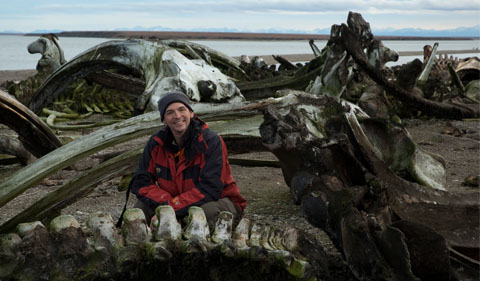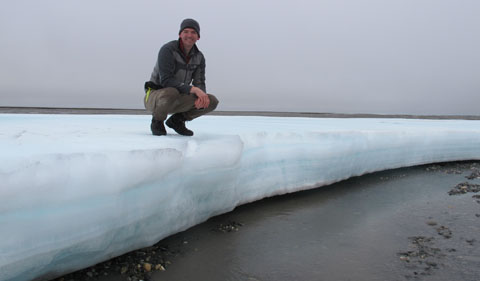
Joshua Miller in a whale graveyard in Kaktovik 2011
The Geological Sciences Colloquium Series presents Joshua Miller on “Tracking ecological change through the Anthropocene and beyond: Insights for paleoecology and conservation biology from bones on the landscape” on Nov. 3 at 4:10 pm in Clippinger 205.
Mueller is a Fenneman Assistant Research Professor at the University of Cincinnati.

Joshua Miller
Abstract: The incomplete nature of the fossil record offers a universal challenge to paleobiology and demands that we understand the biological insight retrievable from preserved remains. Bones laying on modern landscape surfaces offer an opportunity to test the quality and variety of biological data recorded in bone accumulations and to guide our ecological interpretations of fossil deposits. Furthermore, such bone accumulations offer rare historical ecological perspectives potentially useful for evaluating current trends in wildlife populations and communities. Combining standardized bone surveys with ecological surveys of the local living populations, I test how faithfully bone accumulations in a variety of environmental and ecological settings (Yellowstone National Park, the Arctic National Wildlife Refuge (Alaska), Amboseli National Park (Kenya)) record biological metrics from their source communities. Using a combination of carcasses with known dates-of-death and radiocarbon dating, I also test variability in bone survival durations (and impacts on time-averaging potential) due to ecological and environmental factors. Large mammal (ungulate) bone accumulations in Yellowstone faithfully record a multitude about their source community; including species richness, proportional abundance structure, and changes in both through time. Bone accumulations also accurately record season-specific landscape use; shed elk antlers are dropped in late-Winter and faithfully demarcate male wintering areas, while the bones of newborn elk faithfully demarcate Spring birthing grounds. This finding is mirrored in the Arctic National Wildlife Refuge, where high concentrations of shed female caribou antlers (which are dropped within days of giving birth) faithfully record caribou calving (birthing) activity on the landscape. Because bones can survive for millennia on arctic landscapes (only decades in tropical settings), arctic bone accumulations offer particularly dramatic temporal extensions to our understanding of contemporary communities and populations. For paleobiology, these positive findings suggest fossil records have the potential to preserve finer grained biological data than is often considered. For modern ecologists, while bone accumulations are generally undervalued (or completely ignored), they offer unparalleled opportunities to quantify relationships between fundamental aspects of population and community ecology and their biological, climatic, and even human drivers.
Upcoming Colloquia
Michal Kowalewski of the University of Florida on “Tales Told by Dead Shells: Paleobiological Approaches to Historical Ecology and Conservation” on Nov. 8 at 2 p.m. in Walter Hall 235.
Kenneth Brown of West Virginia University on “Crystals as archives into Igneous systems and processes: exploring potassium feldspar megacrysts in granites and granodiorites” on Nov. 17 at 4:10 p.m. in Clippinger 205.
Lindsey Schafer on “Statistical analysis of mining parameters to create empirical models to predict mine pool formation in underground coal mines” and Fred Twumasi on “Modeling of hydrological data to predict mine pool formation and possible discharge locations in underground mines” on Dec. 1 at 4:10 p.m. in Clippinger 205. Both are Geological Sciences graduate students.



















Comments